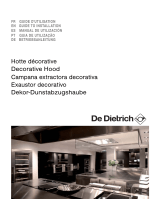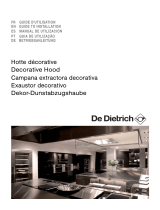ELECTRICAL CONNECTIONS
During installation and maintenance operations, the ap-
pliance must be unplugged from the electrical grid;
fuses must be cut off or removed.
The electrical connections are made before the appli-
ance is installed in its housing.
Ensure that:
- the electrical installation has sufficient voltage,
- the electrical wires are in good condition,
- the diameter of the wires complies with the installation
requirements.
This appliance is delivered with a H 05 VVF power cord
that has three-0.75 mm
2
conductors (neutral, phase and
ground). It must be connected to the main power sup-
ply (which should be a 220-240 V single phase current)
via a CEI 60083 standardised socket that should remain
accessible after installation, in keeping with installation
guidelines.
We cannot be held responsible for any accident result-
ing from an inexistent, defective or incorrect ground
lead. The fuse for your installation must be 10 or 16A.
If the power cable is damaged, call the after-sales serv-
ice department in order to avoid danger.
If the electrical installation at your residence requires
any changes in order to hook up your appliance, call
upon a professional electrician.
If the hood displays any malfunctions, unplug the ap-
pliance or remove the fuse corresponding to the elec-
trical socket where your appliance is plugged in.
The hood must be installed in compliance with all appli-
cable regulations concerning the ventilation of premises.
In France these regulations are described in DTU 61.1
from the CSTB. In particular, the evacuated air should
never be conveyed to a duct used to evacuate smoke
from appliances that use gas or other combustible fuels.
Unused ducts may only be used after approval from a
competent specialist.
The accessible parts of this appliance may become
hot if it is used with a cooking appliance.
1.1 USING THE EVACUATION MODE
If you possess an outlet to the exterior
Your hood can be connected to this outlet using a flue
(minimum diameter Ø mm that is enamelled, in alu-
minium, flexible or made of inflammable material). If
your flue is less than 125 mm in diameter, you must use
the recycling mode.
1.2 - USING THE RECYCLING MODE
If you do not possess an outlet to the exterior
All of our appliances can be used in recycling mode.
In this case, you should add an active carbon filter
which will keep in odours.
0.1
23
1.3 - ASSEMBLING THE HOOD
Important! Do not forget to remove the cables before
assembling the hood completely.
A : Ceiling bracket
B : Deflector (recycling mode only)
C : Ventilation shaft bracket D : Flue (not delivered with
the appliance)
E : Telescoping ventilation shafts
Vent up : recycling mode
Vent down : evacuation mode
F : Adapter (to be used depending on the size of the
flue)G
: Back-flow valve (for outdoor evacuation only)
H : Motor bracket
The minimum distance between the cooking surface
and the lowest part of the hood must be 70 cm. If the
instructions for the hob installed under the hood specify
a distance of more than 70 cm, this requirement must
be respected.
— With the aid of a lead wire, align the centre of the
cooking surface with the ceiling bracket (1.3.1).
— Notch A in the ceiling bracket must be facing the ap-
pliance (1.3.1).
- Fix the ceiling bracket in place using the 4 screws and
wall plugs supplied.
- If your hood is in recycling mode, fix the deflector to
the ceiling bracket using the 2 screws supplied (1.3.2
recycling).
- Connect the flue to the deflector (recycling mode), or
to another flue leading away from the ceiling (evacuation
mode).
- When the ventilation shaft bracket has been correctly
fitted, screw in the 4 screws to hold the hood bracket
in place (1.3.3).
— In outdoor evacuation mode, fit the back-flow valve to
the motor outlet (1.3.4B). This back-flow valve allows ob-
struction of air entering from outside.
— If you are using a 125 mm diameter flue, use the
adapter supplied (1.3.4-A).
If your outdoor flue has a diameter of less than 125 mm,
you must connect your hood in recycling mode.
— Fit the end of the flue to the motor outlet (for recycling
mode) or to the back-flow valve (for evacuation mode).















